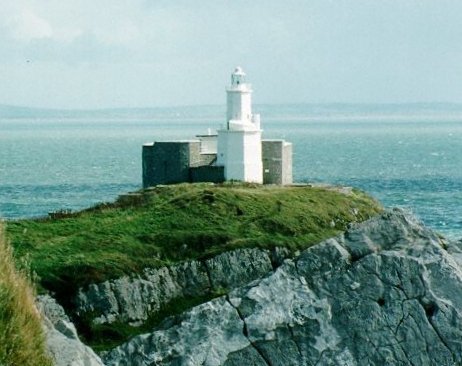

My father, Ramon Jenkins, was born and raised in The Mumbles, Wales, which is a small town overlooking Swansea Bay on the Gower Penninsula. This is the source of my interest in the Mumbles lighthouse and why I have included it here. Like the Chesapeake, Swansea Bay's early history has strong connections to oystering. However, unlike the Chesapeake it has a 43 foot tide, which I have been told is the second largest in the world. The currents generated at the mouth of the Bay by the tide changes make this a particularly dangerous spot when compounded by storms and it has seen numerous shipwrecks over the centuries.
I found the photo above through a web search on the site of Allan Matthews (whom I have never met). He has some very beautiful photos of Gower. This one of the lighthouse is taken from an angle that makes it appear to sit on the edge of a cliff, rather than a small island. It is a little misleading.
The Mumbles lighthouse dates back to 1791 when the Harbour Act provided authority and funding for a light to guide ships into Swansea Bay past the hazardous Mixon Shoal, half a mile to the south. It is located on the outer of two small islands, just off shore, known collectively as the "Mumbles Head". After some initial construction mishaps, the structure was completed and commissioned in 1794. The tower has two tiers because initially two open coal fire lights were displayed. These were difficult to maintain and were soon replaced by a single oil powered (argand lamp) light within a cast iron lantern. In 1860 this was upgraded to a dioptric light and the fort that surrounds the tower was built by the War Department. An occulting mechanism was fitted in 1905 and the light was partially automated in 1934. Later it was fully automated. By 1977 the cast iron lantern had deteriorated beyond repair and had to be removed. A different lantern (taken from Light Vessel number 25) was added ten years later. The most recent major change took place in 1995 when the main light was replaced and array of solar pannels and emergency monitoring equipment added.
When my father was growing up, the lighthouse was still manned, the light was fueled by kerosene, and there was superstructure containing the Fresnel lense and assorted light related apparatus. The lantern (top) was removed in 1977 and to my father it now looks rather strange and naked. When he was a young boy the light house keeper took him and a friend over in a rowboat and showed him how the light worked. This would have been around 1934, either just before or just after partial automation. I decided to write down his recollection of that visit. Here is his story:
"When I was a boy, about 8 years old, I was walking along the pier with Phyllis Bibbs when we saw Joe Hunt walking by carrying a sack. Joe was a master mariner. However, it was the depression and work was scarce, so he was working as the lighthouse keeper. There are two islands off the pier and the lighthouse is on the second island. He was bringing supplies to a rowboat and asked us if we would like to come over and see the lighthouse. We did. So, we climbed backwards down the ladder from the pier into the small boat and he rowed us over. He took us to the top of the lighthouse tower and explained to us how the light worked as he went about his duties. First he filled the kerosene tanks for the night, then used a hand pump to pressurize them. The light used kerosene that was run at pressure through a series of heated tubes. Thus the kerosene was converted to a gas which came out at pressure. The light had mantles, similar to the ones used in a camping light, only much larger and heavier. He poured some alcohol into a tray which was lit to heat up the fuel tubes leading to the mantle. This vaporized the kerosene gas so it could be ignited. (Once the light was lit, the tubes were kept heated by the light's flame.) Next he used a hand crank to wind up a series of weights similar to those used by a grandfather clock (only much larger). These were attached to a lever type mechanism that raised and lowered a metal cylinder around the light (within the Fresnel lens). This is what caused the light to appear to flash. The flashes were of different times, actuated by a cam mechanism. After we were done seeing the light, Joe rowed us back to shore.
During the war, Joe ended up working for the Americans and became a beach master at one of the major landings (because of his master mariner skills and knowledge of tides / shores). So there was Joe Hunt in an American uniform and helmet directing landings under fire."